IoT Protocols are the set of rules and regulations for the secured exchange of data and information maintaining some standard. It is a transportation layer or communication system which is established for securely exchanging data. The Internet of Things protocol manages the communication of data step by step. It is designed in such a way that it ensures data exchange, security mechanism, and architecture of the network.
The IoT devices are connected through the internet via an internet protocol. Some of the IoT devices are connected locally. Because of the advantage of fog computing, many internets of things devices are connected to cloud computing via local devices. IoT Protocols ensure the secured connection of IoT devices, local servers, fog computing, and cloud computing.
The Internet of Things is a new idea of technology. Nowadays, many household devices are connected with IoT. So to transfer data from humans to the machine, there is a requirement of Internet of Things Protocols and Standards.
Those protocols will ensure the safety and security of data transmission. On the other hand, the IoT Protocols set and maintains some standard rules and regulations. In today’s article, we will try to cover a big list of Internet of Things Protocol in short.
Top 30 IoT Protocols
There are different types of IoT protocols based on different purposes. Those protocols are broken into several models and layers. Some of the protocol classifications are infrastructure, identification, transport, discovery, data protocol, device management, semantic and multi-layer framework protocol. To enrich your IoT Skill, we will divide those categories into more details.
1. EnOcean
The first IoT Protocol of today’s discussion is EnOcean. It is widely known for energy harvesting wireless power for industrial applications. This protocol is for smart connections, saving time and resources, and rapid economic growth. It enables a new form of automation based on the wealth of information. This internet of things protocol is widely used for the industrial internet of things or IIoT.
For the uses of smart home-based IoT, automation EnOcean is one of the best IoT protocols. This smart IoT network translates the language of wireless sensors. It has a partnership with many standard IoT platforms
. Some of them are the EEBus initiative, Open Interconnect Consortium, AllSeen Alliance, and OSGi Alliance. You can use this protocol at the smart home, building automation, wireless LED control, outdoor environmental monitoring, and industrial internet (IIoT).
2. XMPP IoT Protocol
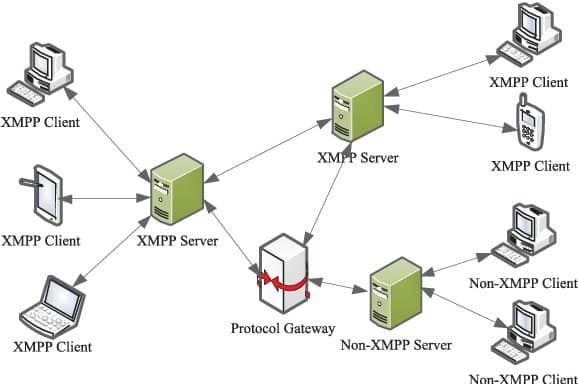 XMPP is a wonderful internet of things protocol that can help you build a solid and secure IoT application IoT service application. It is one of the most secure internets of things protocols that have worked for 10 years profound scalability and security test. XMPP software is available for any programming language, server, toolkits, browser, and client. It provides various choices, such as BOSH – Bidirectional streams over Synchronous HTTP, socket connections, and EXI – Efficient XML Interchange.
XMPP is a wonderful internet of things protocol that can help you build a solid and secure IoT application IoT service application. It is one of the most secure internets of things protocols that have worked for 10 years profound scalability and security test. XMPP software is available for any programming language, server, toolkits, browser, and client. It provides various choices, such as BOSH – Bidirectional streams over Synchronous HTTP, socket connections, and EXI – Efficient XML Interchange.
The most used examples of XMPP internet of things protocol are instant messaging online gaming, and webRTC. For massaging, it supports different quality e of service levels. You can connect different types of sensors, controllers, and actuators with this IoT protocol. It provides human-less functions for automatic decision making, encryption, authentication authorization, and end-to-end encryption.
3. Z-Wave
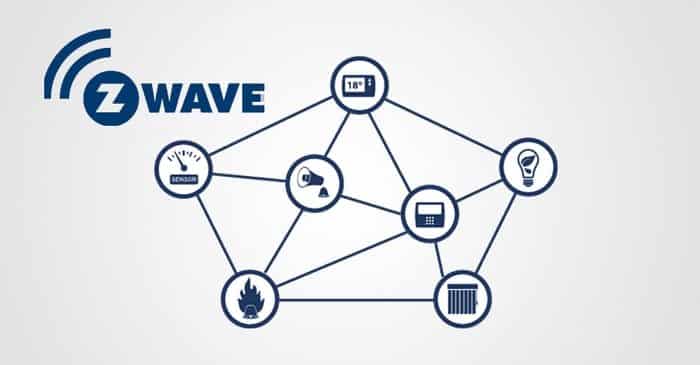 Z-Wave wireless communication protocol, which is used in IoT-based Home Automation. It can communicate a device to a device with low energy using a mesh network. It provides application-layer interoperability between your IoT devices and your controlling gadget.
Z-Wave wireless communication protocol, which is used in IoT-based Home Automation. It can communicate a device to a device with low energy using a mesh network. It provides application-layer interoperability between your IoT devices and your controlling gadget.
Interoperability means one type of application layer which connects hardware and software. This protocol was developed by a Danish company in the year 1999. Within 2019 it has developed many interoperable Z-Wave products.
You can use the Z-Wave IoT protocol for different internet things like security systems, thermostats, swimming pools, windows, locks, lighting control, and garage door openers. Like Bluetooth technology, this internet of things protocol has a limited distance covered capability, a maximum of 100 meters.
More Info
4. RFID
 The Radiofrequency identification system (RFID) is an automated technology that captures data automatically from any object. It records metadata to control the individual target through radio waves. If the question comes to mind, “What is protocol standardization for IoT?” I will tell you the name of RFID IoT Protocols. Because of its bandwidth, range, power consumption features, it can be one of the best internets of things protocols.
The Radiofrequency identification system (RFID) is an automated technology that captures data automatically from any object. It records metadata to control the individual target through radio waves. If the question comes to mind, “What is protocol standardization for IoT?” I will tell you the name of RFID IoT Protocols. Because of its bandwidth, range, power consumption features, it can be one of the best internets of things protocols.
The Internet of Things is a globally connected network that collects data from different sources. RFID is one of the best sources for providing information. An IoT infrastructure generally has three layers: the perception layer, the network layer, and the application layer. The RFID IoT protocol has contributed to all of the layers by providing data.
5. LoRaWAN
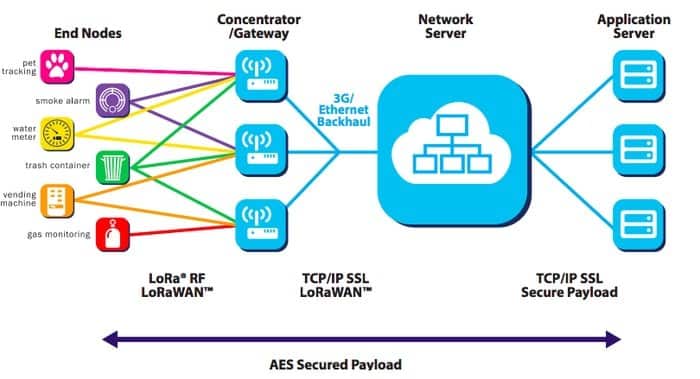 Low Range Wide-area network protocol is another best protocol for IoT. It works on spread spectrum modulation techniques which are derived from CSS technology. CSS refers to the “chirp spread spectrum”. This freeware allows long-range transmission, which is more than 10 kilometers in the rural area. It has already declared to reduce power consumption, reduce its size and increase the power of transmission. For long-range devices, you can use these internet of things protocols.
Low Range Wide-area network protocol is another best protocol for IoT. It works on spread spectrum modulation techniques which are derived from CSS technology. CSS refers to the “chirp spread spectrum”. This freeware allows long-range transmission, which is more than 10 kilometers in the rural area. It has already declared to reduce power consumption, reduce its size and increase the power of transmission. For long-range devices, you can use these internet of things protocols.
6. AMQP
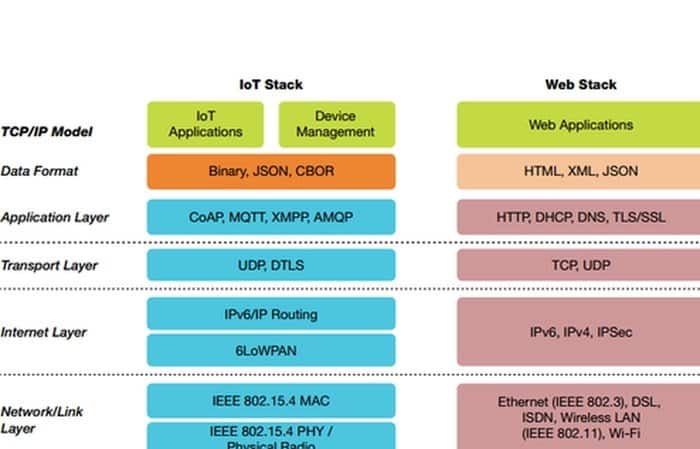 Advanced Message Queuing Protocol, in short AMQP, is an open-source asynchronous messaging protocol. Between the application and organization, it provides interoperable and encrypted messaging facilities. To provide routing and queuing, the AMQP protocol act as middleware. This software layer protocol works for point-to-point connection and supports the secured exchange of data between cloud and connected devices.
Advanced Message Queuing Protocol, in short AMQP, is an open-source asynchronous messaging protocol. Between the application and organization, it provides interoperable and encrypted messaging facilities. To provide routing and queuing, the AMQP protocol act as middleware. This software layer protocol works for point-to-point connection and supports the secured exchange of data between cloud and connected devices.
AMPQ is suitable for IoT device management, client and server messaging services. It has separate components, which are namely Message Queue, Exchange, and Binding. For the banking industry, the AMPQ protocol is widely used. It ensures the delivery of messages to the end-users.
7. Cellular
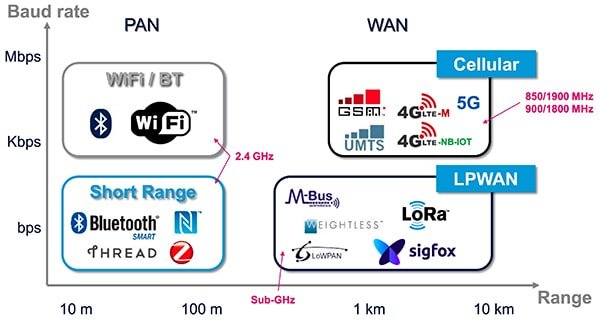 Cellular is another IoT protocol and standard to manage any internet of things development. This communication standard protocol is used for longer and remote distances. It can take the facilities of cellular communication like 3G/4G and even 5G. This IoT Communication Protocol can transmit a large volume of data to any remote place.
Cellular is another IoT protocol and standard to manage any internet of things development. This communication standard protocol is used for longer and remote distances. It can take the facilities of cellular communication like 3G/4G and even 5G. This IoT Communication Protocol can transmit a large volume of data to any remote place.
The Cellular is a costly protocol. On the other hand, it consumes more power than other IoT protocols. But, it is amazing for sensor-based IoT projects, even if it is low bandwidth. The most common examples of this internet of things protocols are Cell phones, M2M, smart meters, and asset tracking.
8. ZigBee
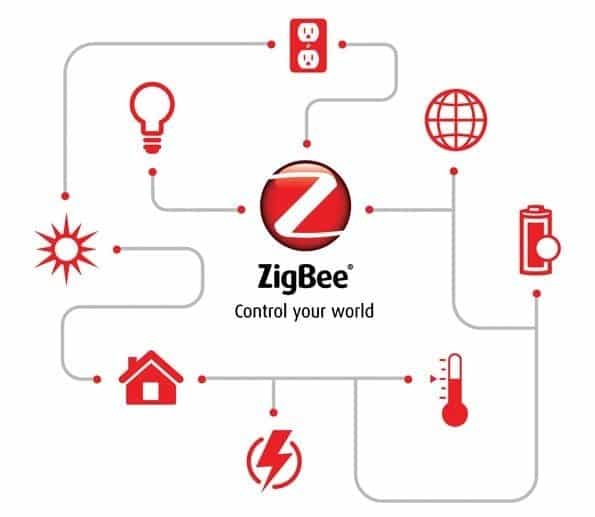 ZigBee is another best protocol for IoT. It is like Bluetooth technology which has a vast amount of users. The industrial internet of things (IIoT) automation is widely used with a 2.4GHz frequency. This high communication protocol is used for medical device data collection, home automation, and other low-power, low-bandwidth needs.
ZigBee is another best protocol for IoT. It is like Bluetooth technology which has a vast amount of users. The industrial internet of things (IIoT) automation is widely used with a 2.4GHz frequency. This high communication protocol is used for medical device data collection, home automation, and other low-power, low-bandwidth needs.
ZigBee is one of the most popular IoT security Protocols. It consumes low power, and the standard distance coverage is between 10 to 100 meters within line of sight. You can integrate it with the radio and microcontroller.
9. WiFi
WiFi is another important standard protocol for IoT. Most of the IoT devices are based on WiFi IoT Protocols. There is an IoT WiFi router to provide better service. It is the most favorite choice for IoT developers. The data transfer rate of this IoT communication protocol is very high. You can send a large volume of data using the WiFi internet of things protocol.
The WiFi standard 802.11 is capable of transferring hundred-megabyte data in a few seconds. It consumes power separately. The effective rate of a good IoT router is more than 100 meters.
10. NFC
 Near field communication or NFC is another important protocol for IoT, which works the same way as RFID. This two-way communication standard is widely used for the door entry system. But, NFC is capable of working on short-distance like RFID. NFC is controllable through the smartphone. For authentication and access, this protocol is used widely.
Near field communication or NFC is another important protocol for IoT, which works the same way as RFID. This two-way communication standard is widely used for the door entry system. But, NFC is capable of working on short-distance like RFID. NFC is controllable through the smartphone. For authentication and access, this protocol is used widely.
NFC technology consists of a smart card and card reader. The card is coded with tag data, including the particulars of the individual. However, it is not limited to authentication, and it can record entries like a gate in, gate out, employee attendance, and many more.
11. DDS
If you search for any real-time internet of things protocols, then you may find the great Data Distribution Service machine-to-machine middleware protocol. This highly effective protocol focuses on real-time performance, interoperable, dependability, high-performance, scalable data exchanges using a publish-subscribe pattern.
The DDS protocol and standard are used in IoT. It has many features lime data marshaling, message addressing, flow control, and delivery. It supports decentralized broker-less architecture to share data between publisher and subscriber. DDS can travel through many forms of transport, including UDP and TCP/IP.
12. CoAP
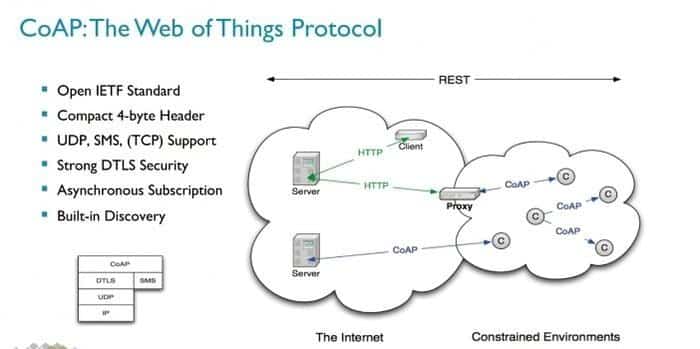 Constrained Application Protocol (CoAP) is another Internet of Things Protocols and Standards that you Must Know. In the internet of things, this web transfer protocol is used with constrained nodes and constrained networks. You can use this protocol for smart energy and building automation. It is designed for machine-to-machine (M2M) applications. So CoAP can be one of the best protocols of IoT.
Constrained Application Protocol (CoAP) is another Internet of Things Protocols and Standards that you Must Know. In the internet of things, this web transfer protocol is used with constrained nodes and constrained networks. You can use this protocol for smart energy and building automation. It is designed for machine-to-machine (M2M) applications. So CoAP can be one of the best protocols of IoT.
CoAP is based on the REST model, and the server makes the resource available. CoAP is not a very expensive protocol, and the required memory and RAM size of this protocol are tiny. RFC 7252 is the internet standard document of CoAP. It also offers different data models that can be integrated with XML, JSON, and CBOR.
13. MQTT
The MQTT stands for Message Queuing Telemetry Transport. A messaging protocol was developed in 1999 by Andy Stanford-Clark (IBM) and Arlen Nipper (Arcom). This protocol is also used for IoT communication and infrastructure. For remote areas, IoT is used for obtaining data from different electrical devices.
MQTT is also a lightweight internet of things protocol that subscribes/publishes operations to publish data between server and client. Moreover, it ensures small size, low power uses, and small data packet implementation for machine learning and the internet.
14. OMA LWM2M
For IoT developers, OMA LWM2M is one of the best IoT protocols. This lightweight M2M protocol is suitable for IoT device management. It is used for resource constraint devices. This light and compact protocol are efficient for resource data models. For the M2M users, it helps in the M2M service. The CoAP protocol is frequently used.
The OMA LWM2M is designed for providing device management functionality using cellular networks or IoT sensors. It can transfer data and instruction from one device to another device. This simple object-based resource model has some functionalities like Connectivity, Access Control, Location, Firmware Update, LwM2M Server, and Connectivity Statistics.
15. AWS IoT Protocols
AWS is one of the best IoT Platforms in the IoT market. It has managed cloud service which has interacted with various cloud services and applications. AWS IoT Core supports trillions of messages and billions of IoT devices. With this IoT core, you can track all of your messages even if they are not connected.
It can manage different services like Amazon CloudWatch, Amazon S3, Amazon SageMaker, AWS Lambda, Amazon DynamoDB, Amazon Kinesis, AWS CloudTrail, and Amazon QuickSight without managing any infrastructure Alexa Voice Service. AWS IoT Protocols are also widely used for developing IoT projects.
16. Websocket IoT
Again to answer the question regarding which protocol is used in IoT, I will answer the name of TCP-based IoT protocols. It is a duplex connection to connect clients and servers. It initial handshake with HTTP and manage a persistent transfer control protocol with the server. Moreover, it allows both server and client to communicate in real-time. Websocket is supported by any Web browser for Windows.
17. Bluetooth Low Energy
Bluetooth is widely used in mobile phones. The diversity of requirements has become an essential communication protocol, including the internet of things. It is used for short-range communication. This communication protocol transmits data from one device to other digital devices at a low cost consuming low power within a limited distance.
Bluetooth is widely used in smartphone wearables and other smart devices. Without the high power of memory, it can transmit the data. Because of the low power requirement and working capability with low memory, it has become one of the best IoT protocols. This protocol works in the 2.4 GHz ISM band. The Maximum distance of Bluetooth technology is 100 meters, and the data rate is up to 3 Mbps.
18. Datagram Transport Layer Security
The question may arise in your mind: what protocol is used in IoT for communication? The answer that may come to my mind is “Datagram Transport Layer Security.” To prevent tampering, eavesdropping, or message forgery, this protocol provides security for datagram-based applications. Some of the applications of these protocols are Cisco AnyConnect, OpenConnect, Cisco InterCloud Fabric, F5 Networks Edge VPN Client, Google Chrome, Opera, and Firefox.
19. IEEE 802.11
Institute of Electrical and Electronics Engineers (IEEE) LAN/MAN Standards Committee (IEEE 802) created this protocol, and they maintain it. IEEE 802.11 is a local area network protocol (LAN) specifies the set of media access control (MAC) and the physical layer. For the wireless computing network standard, this platform. Without connecting with wire, this protocol allows chatting, massaging with each other for the same office using a laptop/computer. This IEEE 802.11 is also used in IoT protocols.
20. Service-Oriented Architecture
The service-oriented architecture of SOA is a flexible and service-level model for IoT constriction. It is an architectural pattern for IoT project design in which application components support other components. It is a vendor-independent technology. You can use the IoT protocol to IP-based homogeneous middleware like QoS, security, and heterogeneity.
21. Modbus
The serial communication protocol Modbus can be an excellent IoT protocol for your IoT projects. You may think that Modbus is a 40 years old protocol, but it has a future regarding IoT. It was used for industry. After the inception of IIoT, the requirement of Modbus again arose. Using this protocol, you can use the Distributed Control Systems (DCS), Industrial Control Systems (ICS), Programmable Logic Controllers (PLC), and/or Variable Frequency Drives (VFD).
Some people don’t believe that Modbus is still not an IoT protocol because it does not meet certain criteria. The difference between MQTT or AMQP, and Modbus is the transport layer protocol. You can use this protocol-free, and there is no licensing cost.
22. Neighbor Discovery Protocol
Neighbor Discovery Protocol is an IoT Protocol that uses internet protocol version 6 (IPv6). It is responsible for gathering information, the configuration of local servers, DNS gateways, and remote communication. There are many improvements after IPv4, which are included in IPv6. Neighbor Unreachability Detection (NUD) can be the best example because of its robustness of packet delivery.
There are five popular NDP types: neighbor advertisement, router advertisement, router solicitation, neighbor solicitation, and network redirects. Since it has solved the limitation of IPv4, therefore, you can use this IoT protocol. Moreover, it is highly secured for our data transmission.
23. Streaming Text Oriented Messaging Protocol
Another IoT messaging protocol is Streaming Text Oriented Messaging Protocol (STOMP). It was previously popular by the name “TTMP”. It is designed for working with message-oriented middleware (MOM). This protocol works over TCP so that it can be compared with the HTTP protocol.
STOMP messaging protocol follows some commands like CONNECT, SEND, SUBSCRIBE, UNSUBSCRIBE, BEGIN, COMMIT, ABORT, ACK, NACK, and DISCONNECT. Some of the common uses of this protocol are Apache ActiveMQ, HornetQ, Open Message Queue (OpenMQ), RabbitMQ, and Syslog-ng through its STOMP destination plugin.
25. HTTP IoT Protocols
Break down large data and requests into manageable chunks. HTTP is a hypertext transfer protocol that uses an application protocol for collaboration distribution and hypermedia information systems. This protocol was developed for the internet, but it can be used for the internet of things. This protocol rides above the TCP protocol. Moreover, all the data of HTTP protocol can be expressed in human-readable ASCCI text.
Though HTTP can be used for the internet of things protocol, some experts do not support using this protocol. HTTP is not suitable for the internet of things because of many reasons. First of all, it can communicate with only two systems at a time. Secondly, it does not fulfill all the requirements of the IoT setup.
Finally, if you want to integrate with a sensor, it will be more difficult because the volume of data emerging from sensors is quite high. Whatever may be the case, HTTP also acknowledged the title of IoT protocol.
25. OPC- Open Platform Communication
The open platform communication officer is a real-time-based internet of things portable. For the manufacturing industry, it is used for machines to a machine communication protocol. This IoT protocol is used for industrial automation. If you think about IoT in manufacturing, then this powerful internet of things protocol may be suitable for you because it can communicate with various control devices at the time of real-time production. It can contract with different manufacturers.
Open platform communication is used in object linking and embedding for process control. It makes the bridge between process control hardware and windows based applications. This protocol is platform-independent so that the coordination between the internet of things devices and the manufacturing plant will be e moisture. Some of these internet of things protocol applications protocol real-time parameter data, historical data, alarm and alert, and commands.
26. Homekit
Homekit is another IoT protocol developed by Apple to provide the connection between IoT-based applications and Apple devices. It is developed for managing smart home appliances over Siri voice command and iOS applications. It allows users to manage and communicate using iOS mobile applications. The users also can give a group of instructions using this protocol.
Homekit IoT protocol can work remotely for food security in cryptid data over iCloud. You also can operate your third-generation Apple TV from the outside of your home because of this protocol. This internet of things protocol was first released in the year 2014. Since its inception, it has tried to produce a loss of IoT-based products and accessories. Some popular accessories are air conditioners, air purifiers, cameras, fans, garage doors, doorbells, humidifiers, lights, locks, outlets, IoT Router, TV, and speakers.
27. Thread
For the IoT, product Thread is another popular protocol. Thread uses 6LoWPAN as a mesh communication protocol. This mesh networking technology works with low power. The Thread network protocol has no cost, but there are some standard rules for its users. Because of the forward datagrams at the network layer, it does not maintain any application layer.
28. BACnet
Building Automation and Control Network, in short, BACnet is a communication protocol used for IoT. This IoT communication protocol is used for smart home applications and IIoT. Some examples of IoT projects are controlling heating, lighting control, access control, ventilating, air-conditioning control (HVAC), and fire detection systems.
29. Sigfox
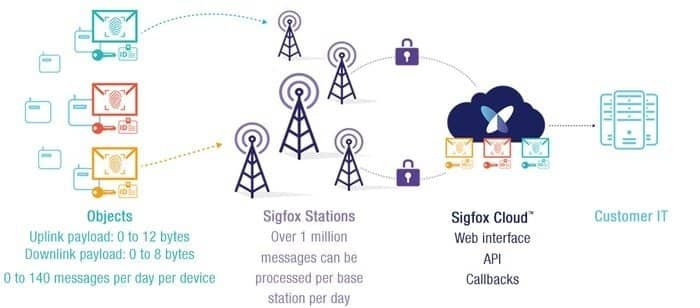 The narrowband LPWAN protocol Sigfox was developed in Toulouse, Franch, in 2009. For a proprietary protocol, this LPWAN technology using the unlicensed ISM bands. It can take up to 140 massages daily per device. The payload size is 12 bytes for each message. It is also a secured protocol for IoT.
The narrowband LPWAN protocol Sigfox was developed in Toulouse, Franch, in 2009. For a proprietary protocol, this LPWAN technology using the unlicensed ISM bands. It can take up to 140 massages daily per device. The payload size is 12 bytes for each message. It is also a secured protocol for IoT.
30. SSI
Simple Sensor Interface or SSI protocol is a communication standard for the internet of things. This simple IoT communication protocol is used for transferring data from the sensor to IoT devices. In the OSI model, it is an application layer protocol. Over UART and networking nanoIP applications, it works on a point-to-point communication system. Among the various IoT Protocols, SSI can be the best one.
Final Thought
IoT Protocols are standard rules and regulations. Each of them is specialized for different functions. It is the jurisdiction of IoT developers to choose the required one. Since the requirement and purpose is different therefore it is difficult to tell which one is best. However, AMQP, Cellular, ZigBee, WiFi, CoAP, and MQTT are the best IoT Protocols.





